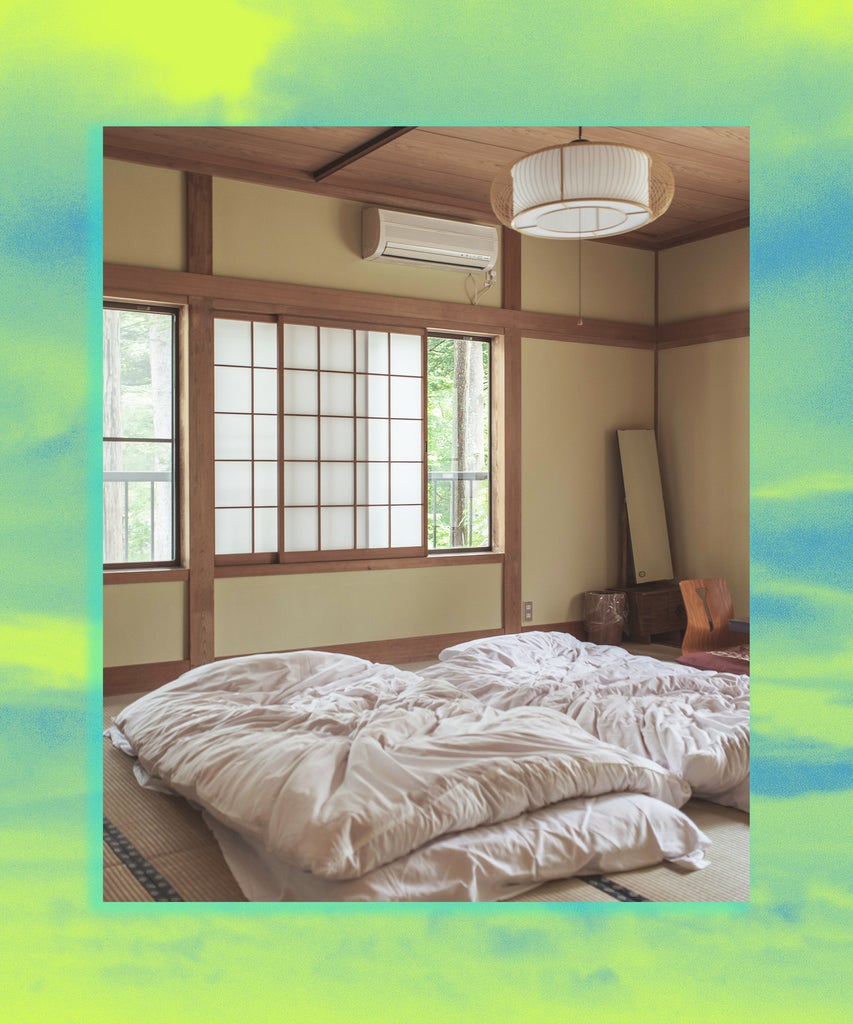
Yawn! Welcome to Sleep Week, a seven-day stretch where we source you the best intel on a good night’s rest as well as the best buys in the Zzz-catching business.
All humans sleep. Whether it’s deep or fractured, long nights or quick naps, lying down or (as Tibetan monks allegedly do) sitting up, the need for Zzzs is fundamental. However where we sleep, and in what, has all sorts of interesting variations around the world.
From Japanese inemuri to Spanish siestas, American comforters to Australian doonas, humans have come up with all sorts of different ways to sleep. Neil Stanley, an independent sleep expert and author of How To Sleep Well, tells Refinery29:
“Beds haven’t really changed an awful lot in history. The change in Western beds came about with the invention of the pocket spring 130 years or so ago. That then gave the standard bed that we lie on nowadays. The next revolution was the foam revolution in the 1980s and that’s really been it for beds. And so various different societies have stopped at various places along that journey.”
Ahead are some of the most noticeable differences in sleeping around the world – you might discover a new way to get the rest you crave, or at least a fun new way to talk about it.
Where’s your bed at?
A bed as a solid piece of furniture is a relatively recent human phenomenon. In order to have one you needed enough room to have something permanent, and that meant money. Historically this is why beds were luxury items. Elizabeth I travelled with hers around the country, while Shakespeare generously bequeathed his second best bed to his wife in his will.
When people have had limited space, they’ve come up with alternatives that have remained part of their culture. The Japanese have the futon, a sleeping system of a mattress base (shikibuton) and a comforter (kakebuton) or blanket (mofu) that can be rolled up and put away. In India, the traditional bed is not a mattress but a light, moveable structure called a charpai: a four-legged base that has a sturdy, woven surface on which to lie.
Then there are dual-purpose beds, like the kang stove bed widely seen in northern China. This heatable brick bed is warmed by the furnace and doubles as a source of warmth as well as a resting place when not sleeping. During the communist era in Poland, the norm was a wersalka, a kind of sofa bed that was the main bed for parents. Based in the living room, it would be folded away during the day.
As for other types of bed, the basic four-poster shape varies by size around the world. Even when the bed as full-time bed is the norm, there are all sorts of regional variations. Take sizing, for instance. A ‘standard’ size bed can vary between different Western countries, making only the slightest difference to the bed itself but making shopping for bedding from other countries very annoying. The American sizes of twin, full, queen and king are different from the UK sizes, which are based on imperial measurements, which are different again from European sizes (which are metric).
(This is why Ikea beds, which are based on Swedish standards, will need sheets from Ikea to fit their mattresses and their linens. Put another way, this is why you should never be suckered into buying bedding at Ikea unless your bed is from there, too.)
Not All Naps Are Created Equal
The Spanish are well known for the siesta, a traditional afternoon nap that dates back thousands of years. Now, it is not reserved for Spain but practised in Italy, Greece, Mexico and the Philippines, too. In Japan they have a very different cultural attitude to napping. Inemuri is the concept of ‘sleeping while being present’, which means it is acceptable to fall asleep anywhere, such as at your desk or when commuting. The understanding is that sleeping is an indication that you’ve worked hard, rather than in places like the UK where it would mean you were lazy.
Okay, But What’s A Doona?
The names we give our bedcovers vary from place to place too. A Japanese bedcover is called a kakebuton and is similar to an American comforter but not a duvet (a comforter is a single-piece, quilted blanket whereas a duvet comes in two pieces: an insert and a cover). For the most part, people use words like duvet, bedding, comforter and linens interchangeably – except in Australia. There, a duvet is a doona and bedsheets are Manchester. Naturally.
(This is because the majority of the cotton used in bedding in Australia originated in Manchester, England and doona was a brand name.)
In many parts of Europe it’s rare these days for people to use a top sheet unless it’s in a hotel. Instead, many use a single duvet or just sheets for warmer climates. In northern Europe, it is also commonplace to have one bed but two duvets (or even two mattresses) so that you’re not automatically woken up every time someone moves in your shared bed. Not a bad idea!
Like what you see? How about some more R29 goodness, right here?
How I Reclaimed A Good Night’s Sleep